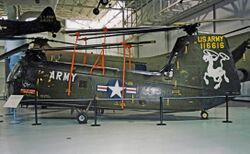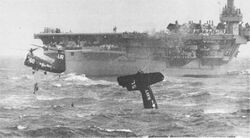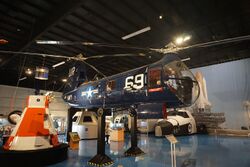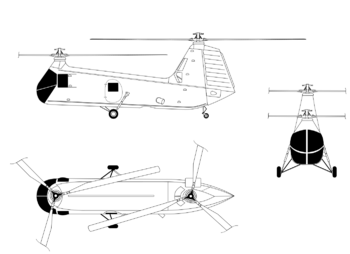Engineering:Piasecki HUP Retriever
| H-25/HUP Retriever | |
|---|---|
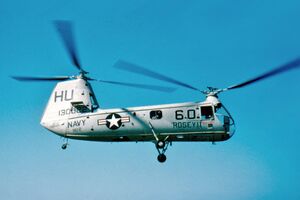
| |
| A U.S. Navy HUP-2 from USS Franklin D. Roosevelt | |
| Role | Utility helicopter |
| Manufacturer | Piasecki Helicopter |
| First flight | March 1948 |
| Introduction | February 1949[1] |
| Retired | 1958 US Army January 1964 RCN 1964 USN 1965 French Navy |
| Primary users | United States Navy United States Army Royal Canadian Navy French Navy |
| Produced | 1949–1954[2] |
| Number built | 339[2][disputed ] |
The Piasecki HUP Retriever/H-25 Army Mule is a compact single radial engine, twin overlapping tandem rotor utility helicopter developed by the Piasecki Helicopter Corporation of Morton, Pennsylvania. Designed to a United States Navy specification, the helicopter was produced from 1949 to 1954, and was also used by the United States Army and foreign navies. The HUP/H-25 was the first helicopter to be produced with an autopilot and also the first to perform a loop.
Design and development
The design was a product of a competition by the U.S. Navy in 1945 for a compact utility/rescue helicopter to operate from ships including aircraft carriers, battleships, and cruisers.[2] Either 2[1] or 3[3][4][disputed ] prototypes—designated PV-14 by the factory and XHJP-1 by the Navy—were built and subjected to a side-by-side flight evaluation against the 3 prototypes of the Sikorsky XHJS-1; however, the XHJS was fundamentally a scaled-up version of the Sikorsky H-5, and the increased weight and size magnified the design's problems with maintaining proper weight and balance under varying loading conditions.[3] The Piasecki won the competition,[3] and with the introduction of the aircraft configuration letter "U" for Utility in the 1950s,[5] the aircraft was ordered for production as the HUP-1.[1]
The design featured two three-bladed, 35-foot-diameter (11 m) rotors in tandem in which blades could be folded for storage; the relatively small rotor diameter allowed the aircraft to use aircraft carrier elevators with its blades fully extended.[2] The tandem overlapping rotor configuration was a development by Piasecki and was used in future helicopter designs by the company and successors including the H-21, HRB-1/CH-46, and CH-47. The original HUP-1 was powered by a single Continental R-975-34 radial engine, with a take-off rating of 525 hp (391 kW), while later versions used the uprated R-975-42 or R-975-46A with 550 hp (410 kW).[1] To aid search and rescue (SAR) operations, the aircraft was equipped with an overhead winch capable of lifting 400 lb (181 kg), which could lower a rescue sling through an electrically-operated door available after the copilot's seat was folded forward.[2]
During a flight demonstration of its capability to withstand high g-force, the type became the first helicopter to perform a loop, albeit unintentionally.[2]
Operational history
The aircraft first entered service in February 1949 with the delivery of the first of 32 HUP-1 aircraft to the US Navy.[1] The improved HUP-2 (Piasecki designation PV-18) was soon introduced with a more powerful engine, deletion of the inward-canted horizontal stabilizer endplate fins, and various minor changes in equipment; a sub-variant equipped with dunking sonar for anti-submarine warfare was given the designation HUP-2S.[1][2] The HUP-2 was the first production helicopter equipped with an autopilot.[2] The US Navy also tested a radio navigation system called Raydist that allowed an unmanned HUP-2 to be directed from a ground station and by radio ordered to hover within five feet (1.5 m) of the desired point.[6] Edo tested a HUP-2 with a fiberglass hull and outrigger floats for amphibious operations.[7]
An upgraded version of the HUP-2 was built for the US Army and designated as the H-25A Army Mule, but most were quickly withdrawn from Army service and converted for naval use under the designation HUP-3.[1][2][8]
In 1954, the Royal Canadian Navy received three former US Army H-25A aircraft, which were modified and redesignated on delivery to conform to US Navy HUP-3 standards.[8][9][10] The aircraft were used aboard HMCS Labrador for search and rescue and varied utility duties, and were later used to support construction at Distant Early Warning Line radar sites.[8][10] The helicopters were subsequently posted to NAF Patricia Bay and naval air station HMCS Shearwater; after the last two were stricken from inventory on 18 January 1964, one aircraft was donated to a technical school and the other two were sold as surplus.[8][10]
The US Army H-25 designation was adopted by the US Navy in 1962[1] on introduction of the 1962 United States Tri-Service aircraft designation system. The final units were withdrawn from US service in 1964.[citation needed] It also served with French Naval Aviation (Aeronavale) from 1953[citation needed] to 1965.[2]
A total of 339 aircraft were delivered during the 6-year production run.[2][disputed ] A large number of surplus US Navy aircraft later appeared on the US civil registry, and at least seven were transferred to the French Navy.[citation needed]
On 7 November 2009, former US Navy HUP-1, BuNo 124925,[11] civil registration number N183YP,[12] collided with high-voltage power lines in Adelanto, California; the subsequent crash and post-crash fire killed all 3 occupants and substantially damaged the aircraft.[12] Operated in association with Classic Rotors, the accident aircraft was the only airworthy example in the world.[11] The National Transportation Safety Board attributed the crash to "The pilot’s failure to maintain clearance from powerlines during en route flight."[12]
Variants
- XHJP-1
- Prototype, powered by a 525 hp (391 kW) Continental R-975-34 piston engine, equipped with large sloping endplate fins on the horizontal stabilizers. Piasecki-Vertol designation was PV-14. 2[1] or 3[3][4] produced.[disputed ]
- HUP-1
- Utility transport and search and rescue helicopter for the US Navy, largely similar to XHJP-1, Piasecki designation was PV-18. 32 built.[1][2]
- HUP-2
- Improved version, 550 hp (410 kW) Continental R-975-42 piston engine, horizontal stabilizer endplate fins eliminated.[1][2] 165 built for the US Navy,[1][disputed ] 15 for French Aeronavale. Redesignated UH-25B in 1962.
- HUP-2S
- Anti-submarine warfare version of HUP-2 fitted with dunking sonar. 12 built.[2]
- HUP-3
- Naval utility conversion of H-25A aircraft transferred from US Army: 50 to US Navy, 3 to Royal Canadian Navy.[8]
- H-25A Army Mule
- Utility transport helicopter for US Army, similar to HUP-2 but powered by a 550 hp (410 kW) Continental R-975-46A piston engine, and fitted with large doors, power-boosted controls, and strengthened floors.[1][2] 70 were delivered from 1953, but they were unsuitable for front-line use,[13] with 53 transferred to the Royal Canadian and US Navies in 1954–1955,[8] and the remaining helicopters used for training, being withdrawn from army service by 1958.[13]
- UH-25B
- HUP-2 redesignated after 1962.
- UH-25C
- HUP-3 redesignated after 1962.
Operators
 Canada
Canada
- Royal Canadian Navy[14]
 France
France
 United States
United States
Surviving aircraft
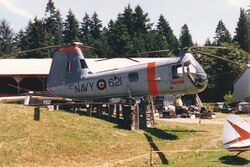
For surviving aircraft, hyphenated numbers are original US Army Serial Numbers; six-digit numbers are original US Navy Bureau of Aeronautics (BuAer) Bureau Numbers (BuNo). All 50 H-25A/HUP-3 aircraft transferred from the US Army to the US Navy were given new bureau numbers; 3 aircraft transferred to the Royal Canadian Navy were redesignated, but retained their original US Army serial numbers.[8]
Canada
- On display
- UH-25B (HUP-2) 128529 at Shearwater Aviation Museum in Shearwater, Nova Scotia.[16] This aircraft has been restored to the appearance of 51-16621, the first Royal Canadian Navy HUP-3.[10]
- UH-25C (HUP-3), 51-16623 - Canada Aviation and Space Museum in Ottawa, Ontario.[17][18]
Netherlands
- UH-25B (HUP-2), 130076 (construction number 253) – Baris Business Park roadway roundabout in Rotterdam. This aircraft was originally used by the US Navy and was later transferred to the French Navy.[19]
United Kingdom
- UH-25C (HUP-3), 51-16622 – displayed at The Helicopter Museum in Weston-super-Mare, England, wearing Canadian markings.[8][20]
United States
- On display
- H-25A Army Mule
- 51-16616 – United States Army Aviation Museum in Fort Rucker, Alabama.[21]
- HUP-1
- 124915 – USS Hornet Museum in Alameda, California.[22]
- UH-25B (HUP-2)
- 128479 – American Helicopter Museum in West Chester, Pennsylvania.[23]
- 128517 – Wings of Freedom Aviation Museum in Horsham, Pennsylvania.[24]
- 128519 – Intrepid Sea, Air & Space Museum in New York City, New York.[25]
- 128596 – Flying Leatherneck Aviation Museum in San Diego, California.[26]
- 130059 – USS Midway Museum in San Diego, California.[27]
- 130082 – on the deck of the USS Iowa Museum in San Pedro, California.[28][29]
- UH-25C (HUP-3)
- 147595 – Pima Air & Space Museum in Tucson, Arizona.[30]
- 147600 – Air Zoo in Kalamazoo, Michigan.[31]
- 147607 – National Naval Aviation Museum in Pensacola, Florida.[32]
- 147628 – Mid-America Air Museum in Liberal, Kansas.[33]
- 51-16621 – Classic Rotors in Ramona, California.[34] As of December 2019, this is the only Piasecki Helicopter-manufactured aircraft with valid FAA aircraft registration.[35] This former Royal Canadian Navy aircraft is reportedly the last HUP/H-25 capable of being restored to airworthy condition; it was exchanged in 2000 by the Canadian Museum of Flight for unflyable HUP-2 128529, which was subsequently traded again in 2002 to the Shearwater Aviation Museum and repainted as 51-16621.[10][16]
- Under restoration or in storage
- UH-25B (HUP-2)
- 128598 - Stored at New England Air Museum in Windsor Locks, Connecticut.[36]
- 130053 – Stored at Quartzsite, Arizona.[37]
- 130063 - Stored at New England Air Museum in Windsor Locks, Connecticut.[36]
- UH-25C (HUP-3)
- 147610 – Yanks Air Museum in Chino, California, in storage.[38]
Specifications (HUP-2)
Data from Jane's All The World's Aircraft 1956–57.[39]
General characteristics
- Crew: two
- Capacity: four passengers
- Length: 56 ft 11 in (17.35 m)
- Height: 13 ft 2 in (4.01 m)
- Empty weight: 4,132 lb (1,874 kg)
- Gross weight: 5,750 lb (2,608 kg)
- Max takeoff weight: 6,100 lb (2,767 kg)
- Powerplant: 1 × Continental R-975-46A 9-cylinder air-cooled radial piston engine, 550 hp (410 kW)
- Main rotor diameter: 2× 35 ft 0 in (10.67 m)
- Main rotor area: 1,924.5 sq ft (178.79 m2) * Blade section: NACA 0012[40]
Performance
- Maximum speed: 105 mph (169 km/h, 91 kn)
- Cruise speed: 80 mph (130 km/h, 70 kn)
- Range: 340 mi (550 km, 300 nmi)
- Service ceiling: 10,000 ft (3,000 m)
- Rate of climb: 1,000 ft/min (5.1 m/s)
- Disk loading: 3 lb/sq ft (15 kg/m2)
- Power/mass: 0.09 hp/lb (0.15 kW/kg)
See also
Related development
- Piasecki H-21
- CH-46 Sea Knight
Aircraft of comparable role, configuration and era
- Bell HSL
- Bristol Belvedere
- Harbin Z-5
- Mil Mi-4
- Sikorsky H-19 Chickasaw
References
- Notes
- ↑ 1.00 1.01 1.02 1.03 1.04 1.05 1.06 1.07 1.08 1.09 1.10 1.11 1.12 Swanborough and Bowers 1976, p.461.
- ↑ 2.00 2.01 2.02 2.03 2.04 2.05 2.06 2.07 2.08 2.09 2.10 2.11 2.12 2.13 2.14 "HUP-1 Retriever/H-25 Army Mule Helicopter". Boeing. https://www.boeing.com/history/products/hup-h-25-army-mule.page.
- ↑ 3.0 3.1 3.2 3.3 Devine, Vinny (10 April 2013). "S-53 (U.S.Navy (XHJS-1)". Igor Sikorsky Historical Archives. https://www.sikorskyarchives.com/S-53%20(U.S.Navy%20(%20XHJS-1).php.
- ↑ 4.0 4.1 "Piasecki PV-14 XHJP-1 US Navy". http://1000aircraftphotos.com/Contributions/WatkinsRay/8891.htm.
- ↑ Swanborough and Bowers 1976, pp.8–9.
- ↑ Hearst Magazines (May 1954). "Radio Waves Hold Helicopter In Fixed Hovering Position". Popular Mechanics (Hearst Magazines): 122. https://books.google.com/books?id=oN0DAAAAMBAJ&pg=PA122.
- ↑ "Picture News: Watertight hull makes helicopter amphibious". Popular Science 172 (2): 149. February 1958.
- ↑ 8.0 8.1 8.2 8.3 8.4 8.5 8.6 8.7 Walker, R.W.R.. "Royal Canadian Navy – HUP detailed list". Canadian Military Aircraft Serial Numbers. http://www.rwrwalker.ca/RCN_HUP_detailed.html.
- ↑ "Piasecki HUP-3". Ingenium Canada - Canada Air and Space Museum. https://ingeniumcanada.org/aviation/collection-research/artifact-piasecki-hup-3.php.
- ↑ 10.0 10.1 10.2 10.3 10.4 10.5 "Piasecki HUP-3". Shearwater Aviation Museum. http://www.shearwateraviationmuseum.ns.ca/exhibits/hup.htm.
- ↑ 11.0 11.1 Allnutt, Richard Mallory (25 December 2009). "Piasecki crash claims three lives". Aircraft Illustrated (Stamford, Lincolnshire, UK: Key Publishing Ltd.). ISSN 0002-2675.
- ↑ 12.0 12.1 12.2 NTSB Aviation Investigation Final Report (Report). National Transportation Safety Board. 18 July 2011. WPR10LA048. https://data.ntsb.gov/carol-repgen/api/Aviation/ReportMain/GenerateNewestReport/75019/pdf. Retrieved 25 February 2023.
- ↑ 13.0 13.1 Harding 1990, pp. 197–198.
- ↑ 14.0 14.1 14.2 14.3 "Piasecki H-25 History". Boeing. http://www.boeing.com/history/boeing/hup.html.
- ↑ "Piasecki PV-18 (HUP/H-25/UH-25) (Photo)". pictaero.com. http://www.pictaero.com/en/pictures/picture,47204.
- ↑ 16.0 16.1 Skaarup, Howard (2009). Canadian Warplanes. Bloomington, Indiana: iUniverse. p. 520. ISBN 978-1-4401-6758-4.
- ↑ "Piasecki HUP Retriever/51-16623." aerialvisuals.ca Retrieved: 5 May 2016.
- ↑ Canada Aviation and Space Museum. "Piasecki HUP-3". techno-science.ca. http://casmuseum.techno-science.ca/en/collection-research/artifact-piasecki-hup-3.php.
- ↑ "De helikopter" (in nl). Baris Groep. 11 November 2013. https://www.baris.nl/onze-helikopter/.
- ↑ "Piasecki HUP Retriever/622 RCN." aerialvisuals.ca Retrieved: 5 May 2016.
- ↑ "Piasecki HUP Retriever/51-16616." aerialvisuals.ca Retrieved: 5 May 2016.
- ↑ "Piasecki HUP Retriever/124915." aerialvisuals.ca Retrieved: 25 April 2017.
- ↑ "Piasecki HUP Retriever/128479." aerialvisuals.ca Retrieved: 5 May 2016.
- ↑ "Piasecki HUP-2 "Retriever"". Wings of Freedom Aviation Museum. http://wingsoffreedommuseum.org/index.php/our-aircraft/13-aircraft/aircraft-rotorcraft/33-aircraft-hup-2-retriever.
- ↑ "Piasecki HUP Retriever/128519." aerialvisuals.ca Retrieved: 5 May 2016.
- ↑ "Piasecki HUP Retriever/128596." aerialvisuals.ca Retrieved: 5 May 2016.
- ↑ "Piasecki HUP Retriever/130059." aerialvisuals.ca Retrieved: 5 May 2016.
- ↑ "Piasecki HUP Retriever/130082." Daily Breeze Retrieved: 25 April 2017.
- ↑ Pacific Battleship Center (2019). "New Exhibits". pacificbattleship.com. https://www.pacificbattleship.com/visit-us/special-exhibits.
- ↑ "Piasecki HUP Retriever/147595." aerialvisuals.ca Retrieved: 5 May 2016.
- ↑ "Piasecki HUP Retriever/147600". http://www.aerialvisuals.ca/AirframeDossier.php?Serial=10772.
- ↑ "Piasecki HUP Retriever/147607." aerialvisuals.ca Retrieved: 5 May 2016.
- ↑ "Piasecki HUP Retriever/147628." aerialvisuals.ca Retrieved: 5 May 2016.
- ↑ Federal Aviation Administration (1 November 2018). "N-Number Inquiry Results N7089F". https://registry.faa.gov/aircraftinquiry/NNum_Results.aspx?NNumbertxt=7089F.
- ↑ Federal Aviation Administration (16 December 2019). "Manufacturer Inquiry Results Piasecki". https://registry.faa.gov/aircraftinquiry/AcftRef_Results.aspx?Mfrtxt=PIASECKI&Modeltxt=&PageNo=1.
- ↑ 36.0 36.1 "Bradley - Museum, Connecticut". http://www.usdemobbed.org.uk/locations.php?location=6388. Retrieved 20 September 2023.
- ↑ "Piasecki HUP Retriever/130053." aerialvisuals.ca Retrieved: 15 July 2021.
- ↑ "Piasecki HUP Retriever/147610." aerialvisuals.ca Retrieved: 5 May 2016.
- ↑ Bridgman 1956, p. 345.
- ↑ Lednicer, David. "The Incomplete Guide to Airfoil Usage". https://m-selig.ae.illinois.edu/ads/aircraft.html.
- Bibliography
- Bridgman, Leonard. Jane's All The World's Aircraft 1956–57. New York: The McGraw-Hill Book Company, 1956.
- Harding, Stephen. U.S. Army Aircraft Since 1947. Shrewsbury, UK:Airlife, 1990. ISBN:1-85310-102-8.
- Swanborough, Gordon; Bowers, Peter M. (1976). United States Navy Aircraft since 1911 (2nd ed.). Annapolis, Maryland: Naval Institute Press. ISBN 0-87021-968-5..
External links
Template:Piasecki/Vertol aircraft
 |
